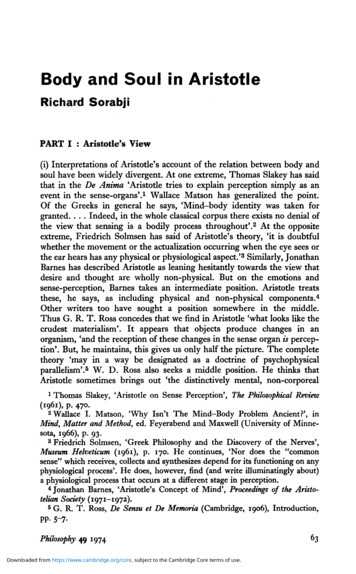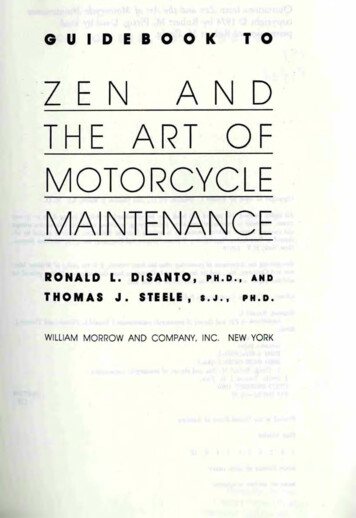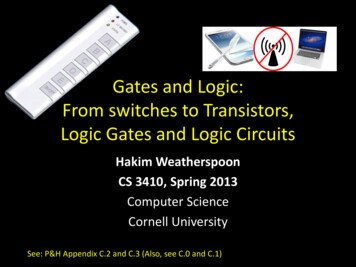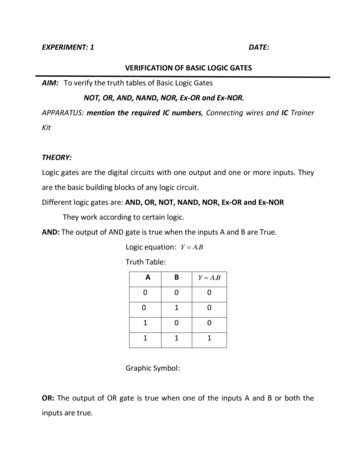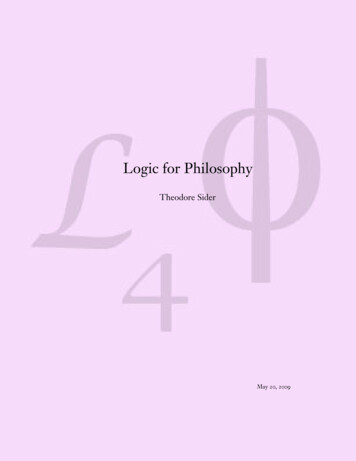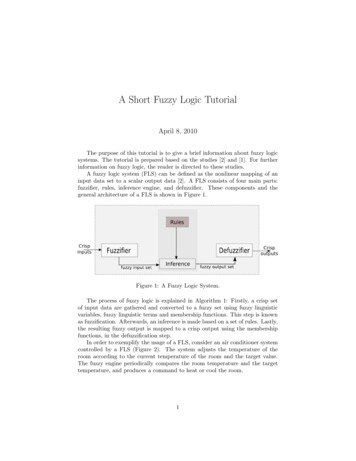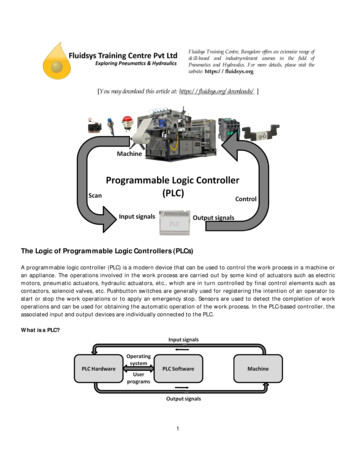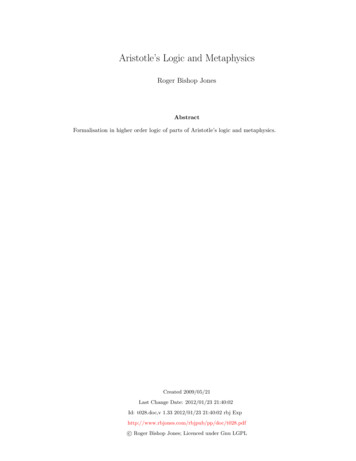
Transcription
Aristotle’s Logic and MetaphysicsRoger Bishop JonesAbstractFormalisation in higher order logic of parts of Aristotle’s logic and metaphysics.Created 2009/05/21Last Change Date: 2012/01/23 21:40:02Id: t028.doc,v 1.33 2012/01/23 21:40:02 rbj Exphttp://www.rbjones.com/rbjpub/pp/doc/t028.pdfc Roger Bishop Jones; Licenced under Gnu LGPL
Contents1 Prelude32 Introduction2.1 Preliminary Formalities . . . . . . . . . . . . . . . . . . . . . . . . . . . . . . . . . . .453 Metaphysics (I)3.1 The Grice/Code/Speranza Formulae3.2 References to Plato . . . . . . . . . .3.3 Aristotelian References . . . . . . . .3.4 Formal Principles . . . . . . . . . . .3.4.1 Categories . . . . . . . . . . .3.4.2 Predication . . . . . . . . . .3.4.3 The Principles in HOL . . . .3.5 Total Definitions . . . . . . . . . . .3.6 Partial Definitions . . . . . . . . . .3.7 Ontological Theorems . . . . . . . .3.8 Platonic Principles and Theorems . .3.9 Some Comments on The Conjectures.4 The Organon4.1 Models and Their Significance . . . . . . .4.2 Preliminaries . . . . . . . . . . . . . . . .4.2.1 Generating the Syllogisms . . . . .4.2.2 The Square of Opposition . . . . .4.2.3 Are The Syllogisms Tautologous? .4.3 Interpretation in Set Theory . . . . . . . .4.3.1 Generating The Propositions . . .4.3.2 Proving the Syllogisms . . . . . . .4.4 Propositional Interpretation . . . . . . . .4.5 Naive Interpretation in Predicate Calculus4.5.1 Semantics . . . . . . . . . . . . . .4.5.2 Predication . . . . . . . . . . . . .4.5.3 The Laws of Immediate Inference .4.5.4 The Square of Opposition . . . . .4.5.5 The Syllogisms . . . . . . . . . . .4.5.6 Generating Syllogisms . . . . . . .4.6 Predicate Calculus Without Empty Terms4.6.1 Semantics . . . . . . . . . . . . . .4.6.2 Predication . . . . . . . . . . . . .4.6.3 Laws of Immediate Inference . . .4.6.4 The Valid Syllogisms . . . . . . . .4.6.5 Proving the Syllogisms . . . . . . .4.7 Existential Import in Universals . . . . . .4.7.1 Semantics . . . . . . . . . . . . . .4.7.2 Predication . . . . . . . . . . . . .4.7.3 The Laws of Immediate Inference .4.7.4 The Square of Opposition . . . . .4.7.5 The Syllogisms . . . . . . . . . . .4.8 Existential Import in Affirmations . . . .4.8.1 Semantics . . . . . . . . . . . . . 43535363637373840404040414243444444
4.8.2 Predication . . . . . . . . . . . .4.8.3 The Laws of Immediate Inference4.8.4 The Square of Opposition . . . .4.8.5 The Syllogisms . . . . . . . . . .4.9 Modal Syllogisms . . . . . . . . . . . . .4.9.1 Semantics . . . . . . . . . . . . .4.9.2 Predication . . . . . . . . . . . .4.9.3 Laws of Immediate Inference . .4.9.4 The Valid Modal Syllogisms . . .4.9.5 General Results . . . . . . . . . .4.9.6 Proving the Syllogisms . . . . . .4.10 Demonstrative Truth . . . . . . . . . . .5 Metaphysics (II)5.1 Semantics . . . . . . . . . . . . . . .5.2 Predication . . . . . . . . . . . . . .5.3 Propositional Operators . . . . . . .5.4 Quantification . . . . . . . . . . . . .5.5 Judgements . . . . . . . . . . . . . .5.6 Conversions . . . . . . . . . . . . . .5.7 Modal Conversions . . . . . . . . . .5.8 Other Conversions . . . . . . . . . .5.9 Syllogisms for Essential Predication .5.10 Some Accidental Syllogisms . . . . .5.11 Grice and Code . . . . . . . . . . . .5.11.1 Common Material . . . . . 676 Conclusions697 Postscript69A Theory ListingsA.1 The Theory ariscat .A.2 The Theory syllog1 .A.3 The Theory syllog2 .A.4 The Theory syllog3 .A.5 The Theory syllog4 .A.6 The Theory syllog5 .A.7 The Theory syllog6 .A.8 The Theory modsyllogA.9 The Theory syllmetapA.10 The Theory gccon . .7172757677798183858791. . .Bibliography93Index951PreludeThis document is intended ultimately to form a chapter of Analyses of Analysis [6].Some of the material is not expected to be in that history including:3
the material up to and including the Prelude the Postscript and any material following it. possibly some other parts which have been marked for exclusionMy original purpose in preparing this document was to analyse certain semi-formal statements,relating to the philosophy of Aristotle, which were posted to the hist-analytic mailing list (see messagein archive) originating primarily in joint work by Grice [4] and Code [3].This has now been overtaken by various other philosophical motivations.Of these the most important for me at present lie in the perceived relevance of Aristotle’s metaphysicsto what I am trying elsewhere to write about Metaphysical Positivism. One tentative idea in thisexposition involves three comparisons intended to illuminate the tension between essentialism andnominalism and inform the search for a middle ground. These three are between Plato and Aristotle,between Hume and Kant, and between Carnap and one or more twentieth century metaphysicians.For this purpose I seek some kind of understanding of Arstotle’s essentialism, and it is for me naturalto use formal modelling as one way of realising that understanding.Since my own backround in formal modelling comes from Computer Science and Information SystemsEngineering, my own preferred languages, methods and tools, which I believe can be effectivelyapplied to some kinds of philosophical problems, are probably alien to most if not all philosophers, andit is therefore a secondary purpose of this material to try to make this kind of modelling intelligibleto some philosophers. This is not a presentation of established methods with proven philosophicalbenefits. It is an exploration and adaptation of methods from other domains to philosophy, and thebenefits, are to be discovered, not merely displayed.The present state of the document is rather rough and ready. Formal modelling takes time, butpresenting such material takes longer, and while I am hot on the trail of better, more illuminatingmodels, the presentation will not be polished and transparent.Further discussion of what might become of this document in the future may be found in my postscript(Section 7).In this document, phrases in coloured text are hyperlinks, like on a web page, which will usually getyou to another part of this document (the blue parts, the contents list, page numbers in the Index)but sometimes take you (the red bits) somewhere altogether different (if you happen to be online)like the hist-analytic archives.For description of the formal languages, methods and tools used in or in producing this documentsee: [5].2IntroductionMy purpose here is to use formal models to aid in understanding the philosophies of Plato andAristotle, both in relation to their contribution generally to the areas of interest, philosophicallogic, semantics and metaphysics, and also more specifically in relation to the extent to which thesephilosophers laid the ground for the distinction which was later expressed in Hume’s fork.In doing this I began with some enquiries into Aristotle’s metaphysics published by Code [3] andproduced from this a preliminary model (Section 3). In these an important defect is that the modeldoes not support the u-p syllogisms on which Code’s analysis depends more heavily than one mighthave expected, and also does not allow for modal operators, which not only enter into Code’s material4
but are also important for the kinds of comparison with later philosophers which I had hoped toundertake. I have also failed at this stage to bring out the distinction between Plato and Aristotle.Perhaps more important is that I did not arrive at a good understanding of Code and the model istherefore unlikely to fully reflect his intensions. It is also the case that the method I adopted for theanalysis of Code is one which he would have been likely to question. His paper does briefly discussunfavourably the interpretation of Aristotle in terms of modern idom such as that of set theory. Itis an important part of my objectives in this document to discuss this kind of formal exgetics, andhopefully to explain contra Code why the use of modern set theoretic language is appropriate andhelpful in the analysis of materials which could not have been originally conceived in such terms.I then went back from the Metaphysics to the Organon and used formal models to come to a betterunderstanding of Aristotle’s formal syllogistic logic (Section 4). In this seven models of increasingsophistication were produced and formed the basis for undertaking a further model of the metaphysicswhich incorporated the u-p syllogisms and modal operators (Section 5). All of this is preliminary toaddressing the real issues, which has not yet seriously begun.2.1Preliminary FormalitiesIn the document several different formal models are presented. By and large they are independent,but a some features are common and are therefore presented here for use in all the models.SMLopen theory "misc2";force new theory "aristotle";We define inequality:SMLdeclare infix (300 , "6 ");HOL Constant 6 : 0 a 0 a BOOL x y x 6 y x y3Metaphysics (I)In this section we consider some material on Aristotle’s Metaphysics [2] which originated in work ofGrice and Code [3] and came to me from a posting of J.L. Speranza on the hist-analytic mailing list.Code’s paper is also partially available at Google Books.What Speranza posted was the list of formulae which are named below as c01 through c31 (thoughnot exactly as given, I have massaged them to be acceptable to HOL and also have quantified overall free variables).The analysis in this section is independent of the preceding analysis of Aristotle’s syllogism, andconsiders predication from a rather different point of view, which hangs around the distinctionbetween essential and accidental predication. In the next section I will produce another model inwhich essence and accident are combined with a full treatment of modal syllogism so that someconclusions might be drawn about the relationship between essence and necessity in Aristoteleanphilosophy.5
A new theory is needed which I will call “ariscat” which is created here:SMLopen theory "aristotle";force new theory "ariscat";3.1The Grice/Code/Speranza FormulaeThis work began with an attempt to analyse using ProofPower a set of formulae posted by J.L.Speranza to the hist-analytic mailing list. These were a Speranzan transcript of formulae publishedin a paper by Code [3], the work presented in that paper having begun with some joint work withH.P. Grice [4].The following material labelled “Code/Speranza” began as a transcription from Speranza’s email,and was later updated when Speranza pointed me to the partial availability of the Code paper onGoogle Books. I then put back some of the detail missed in the Speranza version, enclosed in squarebrackets, and enclosed in curly braces some of the material which Speranza had added to Code’s.The terminology used is Grice’s. Code uses “Is” and “Has” instead of “izz” and “hazz” (which werecoined by Grice and used by Speranza). Aristotle’s originals have been translated as “SAID OF”and “IN”, according to Cohen (Grice and Code on IZZing and HAZZing).The material is interspersed with a formalisation in ProofPower-HOL. I have adopted some of Code’sheadings for sections.3.2References to PlatoBy footnote in Code.30 P haedo. 102B8C 1 with C10ff (cf. B 4-6)3.3Aristotelian ReferencesThese are gathered together temporarily and will later be distributed as footnotes.Cat. 1a , 12–15 Equivocally, Univocally and Derivatively.Cat. 1b 5, 3b12Cat. 2a , 19–34 Presence and Predication.Cat. 3a , 15–20 Subclasses and Predicability.Cat. 10a , 27ff. Opposite, Contrary, Privative, Positive.De. Int. 7, 17a 9–40 Universal and Individual Subjects.P ost. An. A4, 73a 34–b 5 What are the premisses of demonstration. Distinguishing essential andaccidental predication.M etap. I1, 1059a 10 14 The One.6
M etap. 9, 1018a 1 4 Same and Different. ‘Socrates’ and ‘musical Socrates’ are thought to be thesame; but ‘Socrates’ is not predicable of more than one subject, and therefore we do not say’every Socrates’ as we say ’every man’.M etap. 18, 1022a 25 27 In Virtue Of. Admissibility of self-predication of particulars.M etap. 23, 1023a 11 13 Having and Being. Two kinds of predication.M etap. Z5 Only substance is definable.M etap. Z6, 1032a 4 6 Each thing and its essence are one and the same.M etap. Z8, 1034a 7 different in virtue of their matterM etap. Z11, 1037a 33 b 4 Formulae, Parts, Substance and Essence.T opics. H(V II)1, 152b 25 29 Numerical identity.3.4Formal PrinciplesWe begin with “Formal Principles” which we take as implicit definitions of two kinds of Aristotelianpredication.Code/Speranza[(A) Formal Principles][FP1 ][FP2 ][FP3 ][FP4 ]1.2.3.4.A izz A.(A izz B & B izz C ) A izz C .A hazz B (A izz B ).A hazz B iff A hazz Some Thing [something] that izz B .The modelling in ProofPower-HOLwill be entirely conservative, so we provide explicit definitions for“izz” and “hazz” and prove that they satisfy these principles and suffice also for the definitions andtheorems which follow.If the formal development is complete the definitions will have been shown to be sufficient. In orderto test whether the principles suffice I will attempt to proceed on these alone, though I suspect thatwill not be possible. Failing that I will offer informal arguments to the contrary (a formal argumentwould require ascent to a metatheory which would involve too much work).In order to define these concepts we have to decide what they are about, and this is not straightforward.3.4.1CategoriesAristotle has a system of categories, and these seem central to the topic. Much hangs on what theseare, and to get a nice structure to our theory it seems advisable to do a bit of “category theory”first. Of course this is not at all the same thing as the branch of mathematics which now goes bythat name, but the choice of name for the mathematics was not entirely quixotic and at some pointit might be interesting to think about the relationship between the two kinds of category theory.Among these categories that of substances plays a special role. Substances can be particular inwhich case they correspond to some individual, or not, in which case they are sets of individuals.The particulars of the other categories are attributes, and the non-individuals are sets of attributes. I7
don’t think you can have singleton sets, so we can model all these categories as sets of sets in which thesingleton sets are the individuals. Attributes can also be considered as sets of individual substancesand so there is a type difference between the category of substances and the other categories.The following introduce new types and type abbreviations for modelling Aristotle’s categories.ACAT is a type of attribute categoriesISUB is a type of individual substancesCATM is the type of the things which are in categories.This is a ‘disjoint union’, which means that there are two kinds of thing which one finds incategories, either a set of individual substances (using singleton sets to represent individualsubstances), or a set of properties of individual substances tagged with an attribute category.CAT is a type abbreviation for a notion of category which is either an attribute category or someother category (which will stand for the category of substances).There are some oversimplifications here which I am hoping will not be too serious for a useful firstcut.Modal Operators The main one is that this general approach will not permit the definition ofmodal operators, which are used by Code. Whether there is real need for them seems to medoubtful, but if necessary a modal model could be provided.Empty Sets The second is that I have not excluded empty sets, and hence that there can bepredicates with null extensions. This is in fact consistent with Code’s “principles”, but wefind that his definitions are written as if there were no empty predicates, even though this isnot entailed by the principles. Where Code’s definitions presume non-emptiness of predicatesI have chosen another definition which does not. Some of the theorems are then unprovable.Extensionality Intracategorial equality will be extensional. That appears to be what is required,so it probably isn’t a problem!Predicability Aristotle defines particulars in terms of Predicability, they are the impredicables. Itsnot clear how to deal with this, and it appears to be in terminological conflict with Code, whoappears to use use “predicable” to mean “truly predicable”. Code has the general principle “Aizz A” which implicitly asserts that everything is truly predicable of itself.SMLnew type("ACAT ", 0 );new type("ISU B", 0 );declare type abbrev ("CAT M ", [], p:ISUB P (ACAT (ISUB BOOL)P)q);declare type abbrev ("CAT ", [], p:ONE ACAT q);We name the category of substances.HOL ConstantCatSubs : CATCatSubs InL One8
Now we define various operators over categories and their constituents which suffice for the development of an appropriate theory, in the context of which rest of the Aristotelian terminology will wehope prove definable.First “projection” functions which yield the constituents of M CAT s.HOL ConstantCat : CATM CAT x Cat x if IsL x then CatSubs else InR(Fst (OutR x ))HOL ConstantIndvSet : CATM ISUB P x IndvSet x OutL xHOL ConstantAttrSet : CATM (ISUB BOOL)P x AttrSet x Snd (OutR x )This one turns out handy.HOL ConstantCatSet : CATM (ISUB (ISUB BOOL))P x CatSet x if Cat x CatSubsthen {y z z IndvSet x y InL z }else {y z z AttrSet x y InR z }With these definitions in place we get a useful characterisation of identity for elements of CAT M .catm eq lemma A B A B Cat A Cat B CatSet A CatSet B3.4.2PredicationNow we can define predication. We do this in terms of Grice’s izz and hazz.SMLdeclare infix (300 , "izz ");declare infix (300 , "hazz ");HOL Constant izz : CATM CATM BOOL A B A izz B Cat A Cat B CatSet A CatSet B9
HOL Constant hazz : CATM CATM BOOL A B A hazz B Cat A CatSubs Cat B CatSubs a a AttrSet B s s IndvSet A a sThat was reasonably neat, but the definition of izz isn’t terribly convenient for proving things. Letshave some izz lemmas:izz lemma1 A B Cat A CatSubs (A izz B Cat B CatSubs IndvSet A IndvSet B )izz lemma2 A B Cat B CatSubs (A izz B Cat A CatSubs IndvSet A IndvSet B )izz lemma3 A B Cat A CatSubs (A izz B Cat B Cat A AttrSet A AttrSet B )izz lemma4 A B Cat B CatSubs (A izz B Cat B Cat A AttrSet A AttrSet B )3.4.3The Principles in HOLHere are the HOL versions of the Code “Principles”.The following is a bit of program in a programming language called SML, which stands for “StandardMeta Language”! It names various terms in HOL, the name on the left ‘c01’ (short for ‘conjecture1’), the term on the right quoted in “Quine corners”. 1SMLvalvalvalvalc01c02c03c04 p A A izz Aq;p A B C A izz B B izz C A izz C q;p A B A hazz B A izz B q;p A B A hazz B C A hazz C C izz B q;One would expect this set of principles to be sufficient to characterise izz and hazz (i.e. sufficient toderive any other true facts about them) but this seems doubtful.Here are some supplementary conjectures.SMLvalvalvalvalvalc01bc03bc03cc04ac04b p A A hazz Aq;p A B A izz B A hazz B q;p A B A hazz B A B q;p A B C A hazz B B izz C A hazz C q;p A B C A izz B B hazz C A hazz C q;1“Quine corners” are a notation originally used by Quine for Godel numbers, i.e., in Quine’s use ‘p43q’ is a friendlyway of writing doen the Godel number of the numeral ‘43’. In ProofPower HOL these corners are used to refer to HOLterms in the metalanguage SML. In HOL, a formula is a term of type p :BOOLq (the opening p : is used when quotinga type rather than a term).10
Of the supplementaries: c01b is derivable from c03 and c01. c03b is the contrapositive of c03. c03c would be derivable for Code once he has defined equality, it is provable for us now becausewe have a primitive equality. c04a is a preferable formulation of the right-left implication in c04, and we have used it toprove c04. c04b is an obvious further transitivity-like property, which does not look like it’s provable fromthe stipulated principles.Proven Theorems l01l01bl02l03l03bl03cl04al04l04b A A izz AA A hazz AA B C A izz B B izz C A izz CA B A hazz B A izz BA B A izz B A hazz BA B A hazz B A BA B C A hazz B B izz C A hazz CA B A hazz B ( C A hazz C C izz B )A B C A izz B B hazz C A hazz C3.5Total DefinitionsCode/Speranza[(B ) Total Definitions]{6 . (A hazz B & A is a particular ) there is a C such that (C / A) & (A izz B ).}[D1 ][D2 ][D3 ][D4 ][D5 ][D6 ][D7 ]7 . A is predicable of B iff ((B izz A) (B hazz Something that izz A).8 . A is essentially predicable [L predicable] of B iff B izz A.9 . A is accidentally predicable [H predicable] of B iff B hazz something that izz A.10 . A B iff A izz B & B izz A.11 . A is an individual iff (Nec)(For all B ) B izz A A izz B12 . A is a particular iff (Nec)(For all B ) A is predicable of B (A izz B & B izz A)13 . A is a universal iff(Poss) (There is a B ) A is predicable of A[B ] & (A izz B & B izz A)There is a certain amount of duplication of terminology here, since essential and accidental predication seem to be just izz and hazz backwards. I’m not so happy with the “ables” here, for whatis clearly meant is “truly predicable”, which is not quite the same thing. Better names would besimply “is essentially” and “is accidentally”, lacking the ambiguity of “able” (but then they wouldhave to be the other way round, exactly the same as izz and hazz).Anyway here are the definitions (keeping the names (more or less) as they were for the present):11
SMLdeclare infix (300 , "predicable of ");declare infix (300 , "essentially predicable of ");declare infix (300 , "accidentally predicable of ");HOL Constant essentially predicable of : CATM CATM BOOL A B A essentially predicable of B B izz AHOL Constant accidentally predicable of : CATM CATM BOOL A B A accidentally predicable of B B hazz AAristotelian predication is then:HOL Constant predicable of : CATM CATM BOOL A B A predicable of B A essentially predicable of B A accidentally predicable of BBecause we have not precluded empty predicates Code’s definition will not do, and we have to make“individual” primitive, insisting on an individual being a singleton.HOL Constantindividual : CATM BOOL A individual A a CatSet A {a}According to Code’s definition a particular is a substantial individual, we also have to use a moredirect statemant of that principle.HOL Constantparticular : CATM BOOL A particular A individual A Cat A CatSubsAgain we have a problem with Code’s definition and therefore define a universal as a non-particular.HOL Constantuniversal : CATM BOOL A universal A particular A12
SMLvalvalvalvalvalvalvalvalvalc06 p A B A hazz B particular A C C 6 A A izz B q;c06n p A B A hazz B particular A C C 6 A A izz B q;c07 p A B A predicable of B (B izz A) C B hazz C C izz Aq;c08 p A A essentially predicable of B B izz Aq;c09 p A A accidentally predicable of B C B hazz C C izz Aq;c10 p A B A B A izz B B izz Aq;c11 p A B individual A 2( B B izz A A izz B )q;c12 p A particular A 2( B A predicable of B A izz B B izz A)q;c13 p A universal A 3( B (A predicable of B (A izz B B izz A)))q;l05l06nl07l08l09l10 x form x universal x ( A B A hazz B particular A ( C C 6 A A izz B )) A B A predicable of B B izz A ( C B hazz C C izz A) A A essentially predicable of B B izz A A A accidentally predicable of B ( C B hazz C C izz A) A B A B A izz B B izz Ac06 is false (see l06n), probably a typo. However, I couldn’t work out what was intended.c11-13 are not provable in our model because of the existence of empty predicates (and the lack ofmodal operators).3.6Partial DefinitionsCode/Speranza[(C ) Partial Definitions][D8 ] 14 . If A is Some Thing [a this somewhat], A is an individual .[D9 ] 15 . If A is a [(seperable) Platonic] Form,A is Some Thing [a this somewhat] and Universal .This is D8/c14.HOL ConstantSomeT hing : CATM BOOL x SomeThing x individual xA form is a non-substantial individual.This is D9/c15HOL Constantf orm : CATM BOOL x form x SomeThing x universal x13
3.7Ontological TheoremsCode/Speranza[(D) Ontological Theorems][T1 ][T2 ][T3 ][T4 ]{19 .[T5 ]16 . A is predicable of B iff (B izz A) v (B hazz Some Thing that Izz A).17 . A is essentially predicable [L predicable] of A.18 . A is accidentally predicable [H predicable] of B A / BA is not accidentally predicable [H predicable] of A (A is accidentally predicable of B ) A / B .}20 . A is a particular A is an individual .[Note that the converse of T5 is not a theorem][T6 ] 21 . A is a particular No Thing [nothing] that is Not Identical with A izz A.[T7 ] 22 . No Thing is both particular & a [(separable) Platonic] Form.[T8 ] 23 . A is a (seperable Platonic) Form nothing that is not identical with A izz A.[T9 ] 24 . A is a particular there is no (seperable Platonic) form B such that A izz B .[T10 ] 25 . A is a (seperable Platonic) form ((A is predicable of B & A / B ) B hazz A)[T11 ] 26 . (A is a (seperable Platonic) form & B is a particular ) (A is predicable of B iff B hazz lvalc05 p x universal x form x q;c05b p x form x universal x q;c16 p A B A predicable of B (B izz A) C (B hazz C C izz A)q;c17 p A A essentially predicable of Aq;c18 p A A accidentally predicable of B A 6 B q;c19 p A A accidentally predicable of Aq;c20 p A particular A individual Aq;c21 p A particular A C C 6 A C izz Aq;c22 p A particular A form Aq;c23 p A form A C C 6 A C izz Aq;c23b p A form A individual Aq;c24a p A B particular A individual B A izz B particular B q;c24 p A particular A B form B A izz B q;c24b p A particular A form Aq;c25 p A B form A A predicable of B A 6 B B hazz Aq;c26 p A B form A particular B (A predicable of B B hazz A)q;These are the ones I have proved.l16l17l19l20l22 A B A predicable of B B izz A ( C B hazz C C izz A) A A essentially predicable of A A A accidentally predicable of A A individual A particular A ( A particular A form A)14
l23bl24al24l26 A form A individual AA B particular A individual B A izz B particular BA particular A ( B form B A izz B )A B form A particular B (A predicable of B B hazz A)T6/c21, T8/c23, T10/c25 are all unprovable because of the existence of empty predicates.3.8Platonic Principles and TheoremsThis section is a bit of a mess. I now see that the reason for this is that Code is now presenting adifferent theory here, which is Aristotle’s conception of Plato’s metaphysics. This explains why theseprinciples at least augment (and possibly contradict) concepts which have already been defined.In our method, which involves, for the sake of ensuring consistency, the use of only conservativeextensions, this cannot be done simply by adding new principles. We have to develop two systems inseparate theories in which the differences of conception between Aristotle and Aristotle’s conceptionof Plato are investigated in distinct contexts (though we could place in a single parent theory theelements which are common to both).This will be considered later.Code/Speranza[(E ) Platonic Principle][PP1 ] 5 . Each unive
3 Metaphysics (I) In this section we consider some material on Aristotle’s Metaphysics [2] which originated in work of Grice and Code [3] and came to me from aposting of J.L. Speranzaon the hist-analytic mailing list. Code’s paper is


